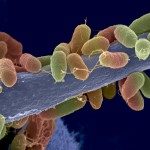Link to Pubmed [PMID] – 21247460
Genome Biol. 2011;12(1):R7
BACKGROUND: Millions of humans and animals suffer from superficial infections caused by a group of highly specialized filamentous fungi, the dermatophytes, which exclusively infect keratinized host structures. To provide broad insights into the molecular basis of the pathogenicity-associated traits, we report the first genome sequences of two closely phylogenetically related dermatophytes, Arthroderma benhamiae and Trichophyton verrucosum, both of which induce highly inflammatory infections in humans.
RESULTS: 97% of the 22.5 megabase genome sequences of A. benhamiae and T. verrucosum are unambiguously alignable and collinear. To unravel dermatophyte-specific virulence-associated traits, we compared sets of potentially pathogenicity-associated proteins, such as secreted proteases and enzymes involved in secondary metabolite production, with those of closely related onygenales (Coccidioides species) and the mould Aspergillus fumigatus. The comparisons revealed expansion of several gene families in dermatophytes and disclosed the peculiarities of the dermatophyte secondary metabolite gene sets. Secretion of proteases and other hydrolytic enzymes by A. benhamiae was proven experimentally by a global secretome analysis during keratin degradation. Molecular insights into the interaction of A. benhamiae with human keratinocytes were obtained for the first time by global transcriptome profiling. Given that A. benhamiae is able to undergo mating, a detailed comparison of the genomes further unraveled the genetic basis of sexual reproduction in this species.
CONCLUSIONS: Our results enlighten the genetic basis of fundamental and putatively virulence-related traits of dermatophytes, advancing future research on these medically important pathogens.

